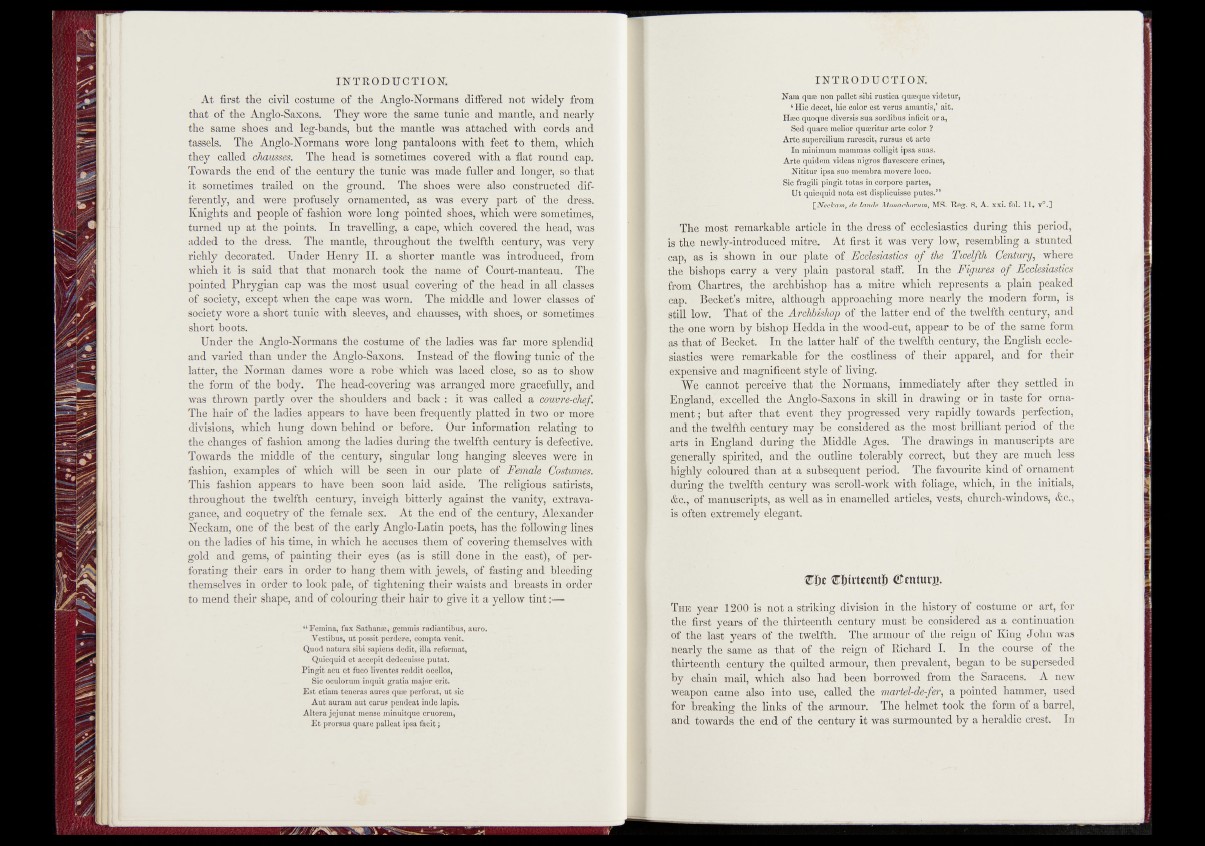
At first the civil costume of the Anglo-Normans differed not widely from
that of the Anglo-Saxons. They wore the same tunic and mantle, and nearly1
the same shoes and leg-bands, but the mantle was attached with cords and
tassels. The Anglo-Normans wore long pantaloons with feet to them, which
they called cfiausses. The head is sometimes covered with a flat round cap;
Towards the end of the century the tunic was made fuller and longer,-so that
it sometimes trailed on the ground. The. shoes were also constructed differently,
and were profusely ornamented, as was every part of the dress.
Knights and people of fashion wore long pointed shoes, which were sometimes,
turned up a t the points. In travelling, a cape, which .covered the head, was
added to the dress. The mantle, throughout the twelfth century, was very
richly decorated. Under Henry II. a shorter mantle was introduced, from
which it is said that that monarch took the name of Court-manteau. The
pointed Phrygian cap was the most usual covering of the head in all classes
of society, except when the cape was worn. The middle and lower classes of
Society wore a short tunic with sleeves, and chausses, .with shoes, or Sometimes .
short boots.
Under the Anglo-Normans the costume of the ladies was far more splendid
and varied than under the Anglo-Saxons. Instead of the flowing tunic of the
latter, the Norman dames wore a robe which was laced close,- so as to show
the form of the body. The head-covering was arranged more gracefully, and
was thrown partly over the shoulders and back : it was- called a -couvre-chef.
The hair of the ladies appears to have been frequently_platted in two or more
divisions, which hung down behind'or before,' Our information relating t(^
the changes of fashion among the ladies during the twelfth century is defective*
Towards the middle of the century, singular long hanging sleeves were in
fashion, examples of which will be seen in our plate o f Female Costumes.
This fashion appears to have been soon laid aside, The religious satirists,
throughout the twelfth century, inveigh bitterly against the vanity, extravagance,
and coquetry of the female sex. At the end of the century, Alexander
Neckam, one of the best of the early Anglo-Latin poets, has the following lines
on the ladies of his time, in which he accuses them of covering themselves with
gold and gems, of painting their “eyes (as is still done in the .east), of per*
forating their ears in order ta hang them with jewels,, pf fasting and' bleeding
themselves in order to look pale, of tightening their waists and breasts in order
to mend their shape, and of colouring their hair- to give it a yellow tin t:—
Femiria, fax Satbatisa^gemmis radiantibus, auro.
Vestibus, ut possit perdere, compta venit.
Quod natura sibi sapiens dedifc, ilia reformat,
Quicquid et accepit dédecuisse pütat.
Pin git acu et fuco liven tes reddit boeilos,
Sic oculorum inquit gratia major erit* r
Est etiam teneras aures quae perforai, ut sic
Aut auram aut carus pendeat inde lapis.
Altera jejunat mense minuitque cruorem,
Et prorsus quare palleat ipsa facit
Nam qua non pallet sibi rustica quteque videtur,
‘ Hio decet, hie color est verus amantis,’ ait.
Hsec quoque diversis sua sordibus inficit or a,
Sed quare melior quserifcur arte color ?
Arte supercilium rarescit, rursus et arte
In minimum mammas cblligit ipsa suas.
Arte quidem videas nigros flavescere crines, •
Nititur ipsa suo membra motere loco.
Sic fragtli pingit totas in edrpore partes,
quicqtiid nota est displicuisse putes.”
[Neckam, de laude Monachorum, MS. Beg. 8, A. xxi. fol. 11, v°.J
The most remarkable article in the dress of ecclesiastics during this period,
is the newly-introduced mitre. At-first I t was very low, resembling a stunted
cap, as is shown in Pur plate ofy Ecclesigptics o f the Twelfth Century, where
the.1 bishops carry a very -plain pastoral, staff.: In the Figures o f Ecclesiastics
from-Chartres, the darchbishop has a mitre- which represents a plain peaked
cap. Becket’s mitre, although approaching, more- nearly the modern form, is
still low .T h a t of the Archbishop of the lafjTer -end of the twelfth century, and
the one worn by bishop Hedda in the ‘iVopd-cut, appear to be of the same form
as that of Becket. In the latter half of the twelfth century, the English ecclesiastics
were remarkable for the costliness of their apparel, and for their
expensive .and magnificent style of lining.
we|iannot perceive that i the Normans, immediately after they settled in
England,/excelled the Anglo-Saxons in skill in 'drawing or in taste for ornament;
but after that event they progressed very rapidly towards'perfection,?
and the twelfth century may be considered’as the most brilliant pMod of: the
.arts in England during the'Middle Ages.- The drawihgs in manuscripts are
generally spirited, and the »outline tolerably cprrect, but they are much less
highlj|;coloured- than at a subsequent period. The .favourite kind of ornament
during the twelfth century was scroll-work with foliage, which,- in the initials,
&c., of manuscripts, as well as in enamelled articles, vests; -Church-windows, &c.v
is often extremely elegant.
HZijt €f)irterot|) ©enturg.
The year 1200 is not a striking division in the history1 of .costume or art, for
the first years of title -thirteenth century must ^considered as a continuation
of the last years of the twelfth. The armour of tke reign of King John was
nearly the same as that 6f the, reign of Richard I. In the course'of the
thirteenth century the quilted armour, then prevalent, began to be superseded
by chain mail, which also had been borrowed from the Saracens. A new
weapon came also , into use, called the martel-elq-fer, a pointed hammer, used
for breaking the links of the armour. The helmet took the form of a barrel,
and towards the end of the century it was surmounted by a heraldic crest. In